1961 | 1962 | 1963 | 1964 | 1965 | 1966 | 1967 | 1968 | 1969 | 1970 | 1971 | 1972 | 1973
Currently ( Jan 2010 ) most internet information states that the team started in 1963.
This is not true. The team was actually formed in 1961. I know that a book will be appearing soon ( Author David Watkins ), this will also show 1961 as the date the team was formed.
Another area of uncertainty is the teams name & it's origin.
Flt Lt Hugh Rigg was one of the founding members of the team. Here's what we wrote :-
My credentials are that I was a founder member of Gin Section, way back in 1961.
Up until 1960 the Linton station formation aerobatics team had been formed by the Advanced Squadron which flew Vampire T11s. (Linton was the Flying Training School for the Navy, and comprised a Basic Sqn, an Advanced Sqn and a Headquarters Sqn, the latter being a small unit which looked after the instructional standards on the station.)
The Vampire team was known as Jet Black, the leader being one Flt Lt George Black who had done an exchange tour with the Navy and had flown Sea Hawks operationally with them in the Suez affair.
Late in 1960 the Jet Provost T3 started to arrive at Linton replacing the Piston Provost, and the station hierarchy decided that the aero team for 1961 should be formed by the Basic Sqn on the JP.
I can't remember how, but a team of four came together under Flt Ron Corck, No 2 was Lt Carl Davis, I was No 3 and Flt Lt Dick Fox was No 4.
Ron and I had both been on 60 Sqn in Singapore in the 1950s, and that illustrious sqn always used Gin, Whisky, Brandy etc as names for its formations as opposed to the usual Red, White, Blue etc, and we decided to call ourselves Gin Section.
So that's how we came into being.
I remained with the team from 61 to 63, when I became the leader,
Hugh also wrote :-
We started as a 4 aircraft formation ......., but sometime in early 1961 there was an accident elsewhere in Flying Training Command involving a 4 Ac [Aircraft] formation, and the then AOC, ....., decreed that we should cut to a 3 Ac formation, and Dick Fox, our No 4, had to leave us.
This was before we had done any displays, so we were only ever seen, again in my time to end 63, as a 3 Ac formation.
This setback didn't end Dick Fox's aerobatic career though as he flew in the CFS team ( later known as the Red Pelicans ) in 1962.
So, there we have it, straight from the horses mouth. The team WAS formed in 1961, as a 3 ship team with the name "GIN Section".
The aircraft used for the 1961 season were standard Jet Provost T3 trainers. No special markings were applied to the aircraft. The team had no special markings on their uniforms or helmets. As was normal till the team disbanded, all training flights & shows were done outside the pilots regular working hours.
The team flew 5 shows over 5 weekends in June & July 1961. 4 of these shows were at Navy bases & as far apart as Culdrose ( Cornwall ) & Arbroath ( Scotland )
I'm not aware of the team having a Manager / Commentator or spare pilot
The major change for 1962 however, were the aircraft. The team went from flying Jet Provost T3's to using the new T4.
Robbie Robinson wrote :- "I see that I flew formation aeros trips from March '62 onwards but the first mention of "GIN" in my log-book is on 9 April '62 ...... We started to use the JP4 on 6 June which was a bit better than the JP3 which was so under powered that in a Barrel Roll the Leader was throttled back, The outside man needed full power while the inside man was fully throttled back with the airbrakes out."
This team only flew 4 shows on 2 weekends, 3 of these shows ( RAF Finningley, RAF Hullavington & RAF Benson ) were flown on 15 Sept 1962 ( Battle of Britain day )
Hugh was cleared as leader by the CO of the Basic Sqn at Linton, Sqn Ldr John Christey, on 18 July 1963. This new team flew their first show 9 days later !
All the pilots in the 1963 season were RAF pilots. For the first time no Navy pilots were in the team.
1963 is widely published as being the formation year for the team. This is possibly because an article was printed in the Yorkshire Evening Post on 9 August 1963 covering the team. This is the first mention of the team , in print, that I have been able to find ( yet ) => Click here to see the article
Pete Jarvis was the Linton Aerobatic Solo Representative from 1963 - 1966. During this period he flew some of the same shows as the team. They flew as a 4-some to & from these shows, displaying seperately over the weekend.
The two incarnations of the 1963 team flew 8 shows over 7 weekends.
For 1964, Terry Thornton took over the lead. Simon Thomas & John Carver joined the team. Both were Navy Lieutenants.
6 Shows were flown over 5 weekends.
Unfortunately I have very little info on this team. 1 single photo of the members. I don't have a full list of their shows.
Again I have very little info on this team.
Interestingly, the "Air-Britain Digest" magazine from November 1966 lists 4 Jet Provosts flying in the Battle of Britain display at St Mawgan. No date is mentioned for the show. Was this the first 4 ship GIN show ?
Here's Norrie Grove's helmet for the 1966 season. Interestingly painted blue, a colour used in later years.
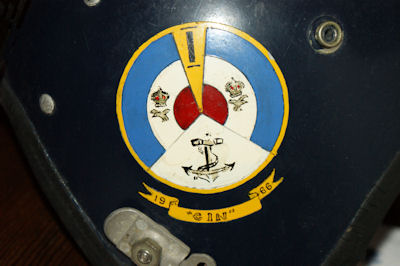
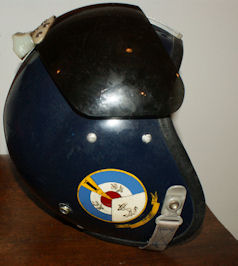
These photo's were kindly sent to via by Mrs Norrie Grove.
The number of shows & season length was also increasing with 14 shows being flown over 13 weekends between May & October.
Unfortunately Pat Kiggell was posted away, at short notice, before the end of the 1968 season. This time however, there was enough time to re-train '67 team member Fg Off Brian Todd to fly in Pat's slot.
Richard "Mac" MacKenzie-Crooks was also posted away at the end of the '68 season. He went to CFS & immediately joined the Red Pelicans !
The "team" flew 14 shows over 13 weekends in 1968.
As with all previous teams the aircraft were "normal" JP trainers, not marked up in any way whatsoever.
However there were some small differences in the background. Perhaps the first real steps towards the complete package that we expect from an Aerobatic team nowadays.
For display weekends, the team had "special" flying suits. This photo was taken at the RAF Valley show in 1968. Brian Todd's suit ( right ) is the standard RAF suit. The other 3 are "team" suits. As well as the suit colour, it looks like the team suits had a special name patch on the right breast.
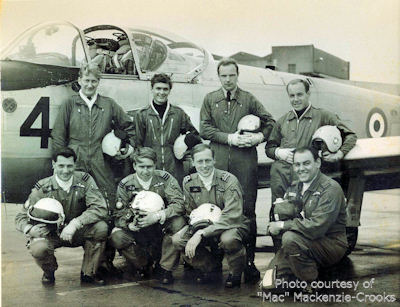
Ground crew - Standing - f-l-t-r ????,?????, Phil Wallace, Bradley
Pilots kneeling f-l-t-r Mike Collin, Richard "Mac" Mackenzie-Crooks, Dave Brittain, Brian Todd
You may have also noticed that the 3 "regular" team members have white helmets & Brian doesn't. Now look more closely at the back of "Mac" MacKenzie-Crooks & Dave Brittains helmets. Here's a blowup of "Macs"
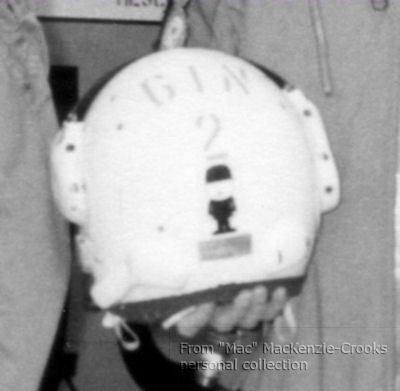
Each of the "regular" 1968 members had a "Fred - the Hompride man" painted on the back of their helmet. Each member had a slightly different facial expression.
Pat Kiggell wrote this :- "The idea of sporting a connection with Homepride came from one of the 4 of us, as we had no logo or a/c ID and because it was a very popular , family-friendly and smoothly packaged & sold product at the time( " Homepride finer grain makes finer flour " ). A subsequent approach was very well -received and resulted in several almost life -sized cardboard replicas of bowler - hatted Homepride flour graders and stickers arriving in the post. Individual opinion varies of course , but my view was that it would be beneficial for us to be associated with with a product well -known for its emphasis on smoothness. It was also done for a bit of light heartedness."
Can you imagine an RAF team wanting to carry something like this on their helmets nowadays ? Firstly it wouldn't be for free & Secondly it would be used by the company in loads of adverts & publicity .... How times have changed !
This may also be the first of the various name changes that the team went through.
Pat Kiggell ( 68 member ) wrote :-
I've always known The GIN Formation Team to be referred to as "GIN Formation" and certainly recall that the latter was also used as our callsign ( sometimes shortened to "GIN" ). My associated log book entries reflect this understanding - in that they are all recorded as GIN Formation Aeros Practices or Displays.
1968 is the first time I have been able to find any reference to a Team Manager. It was Sqn Ldr Sid Edwards who went on to lead the 1969 team.
1969 was a huge change for the team.
To the public the most noticeable change were the aircraft.
In early 1969 all RAF trainers were getting repainted in their now familiar Red, White & Black colours. The team wasted no time in painting their new name "Linton GIN" on the ends of the tip tanks. The "official" Logo has some black shading around the white GIN letters.
This picture shows the logo on the tip tank & a number of other items.
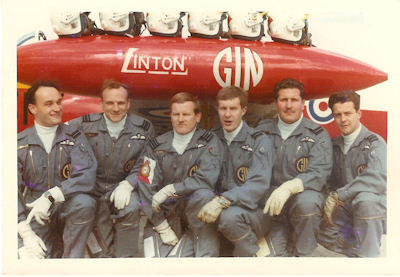
f-l-t-r John Bishop ( reserve ), Dave Waddington, Sid Edwards (Leader), Joe Whitfield, Al Colesky, Dave Coldicutt ( reserve )
The above photo also shows the teams flying suits & new official patch ( on the left breast ).
This picture shows that there was now a new GIN logo on the backs of the helmets.
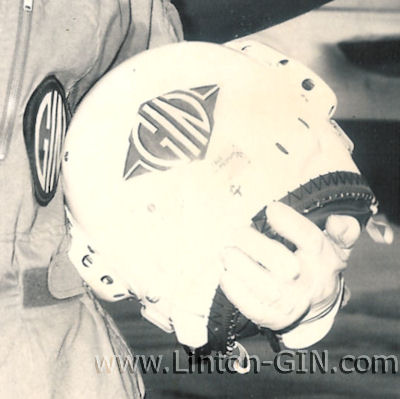
Again all members were new & 1969 was the first time the team was lead by a Squadron Leader. The team consisted of Sqn Ldr Sid Edwards (Leader), Fg Off Joe Whitfield, Fg Off Al Colesky and Flt Lt Dave Waddington As well as having the 4 regular team members, there were 2 official reserves. ( Flt Lt Dave Coldicutt & Fg Off John Bishop )
The reserves flew as much as possible with the team, either in a 5th aircraft, sitting in the spare seat or replacing one of the "regular" pilots for a training flight. In the end they were never needed to replace a team member, but they often attended shows, giving a commentary to the show over the Airfields tannoy system There is no doubt these reserves were willing & very capable of stepping in to cover for any missing pilot.
This is also the first time that the team gave a show outside British airspace. They flew im Münster, Germany. ( York's twin town )
In total 23 shows were flown over 20 weekends between April & September. Remember all training & shows were done in the pilots spare time, before or after "normal" work or at weekends.
Another "background" change for the team was the fact that they sometimes took a Royal Navy Sea Prince to their shows. This would carry some of the groundcrew & aircraft spares.
Phil Pain took this shot, at the Upper Heyford show in June 1969, showing the Sea Prince.
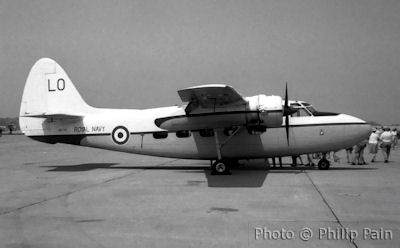
The 1969 team was really taking major steps to becoming the complete package of Aerobatic team as we now know them.
Finally, a minor point, The team had "official" Ties ... So even evening / off duty clothes were being made for the team.
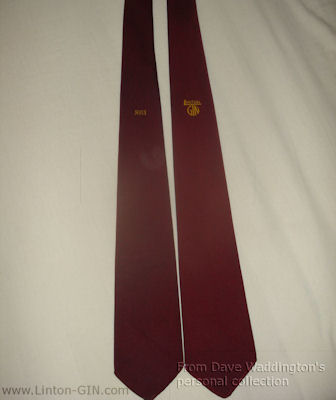
I leave the last words for the 1969 leader Sid :- 1969 was a turning point for Linton Gin. This did not come from above, either at RAF Linton-on-Ouse or from higher up the chain. It was my conscious effort to take advantage of the tremendous professionalism and enthusiasm of our Team to "let them have their head" and encourage any ideas that would thrust us into the public eye and do as many shows as possible. I was extremely lucky that my Chief Flying Instructor (Wing Commander Peter Middleton) and Station Commander (Group Captain John Lewis) both gave me complete freedom and total support in anything I wanted to do with the Team.
Three of the regular '69 team members & reserves made the '70 team.
1970 was to be the last time the team was not lead by a Squadron Leader. This honour falling to Flt Lt Dave Waddington. Flt Lt Joe Whitfield kept his place, Flt Lt Dave Coldicutt swapped his reserve place for a full-time seat & Fg Off Dudley Carvell was the new member ( Dudley went onto fly with the Red Arrows 77 - 80 ). The team was managed by Sqn Ldr Bob Turner.
Whilst these changes may not have been apparent to the public, the Re-naming of the team as "The Linton Blades" was !.
Joe Whitfield ( '69 & '70 pilot ) commented :-
The name was changed by order from the AOC 23 Group who was concerned as to the link to booze!
The correct name was the Linton Blades and as you can imagine even in those far off days we got some stick from our fellow pilots as to our sexuality (Gay Blades etc.)
Here are a couple of newspaper clipping from 1970 "advertising" the name change, however both claim the new name was "The Blades".
This left clipping is from the Daily Telegraph dated 8 April 1970, the right clipping is from an unknown paper, although the photo is credited to the Yorkshire Post.
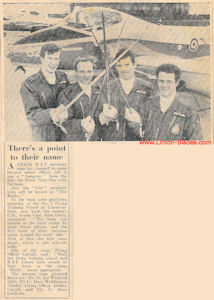
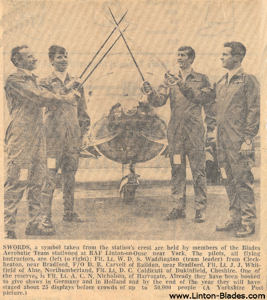
The teams proper name was however "The Linton Blades". Here's Dave Waddington's "uniform patch" for the 1970 season clearly showing the teams new name.
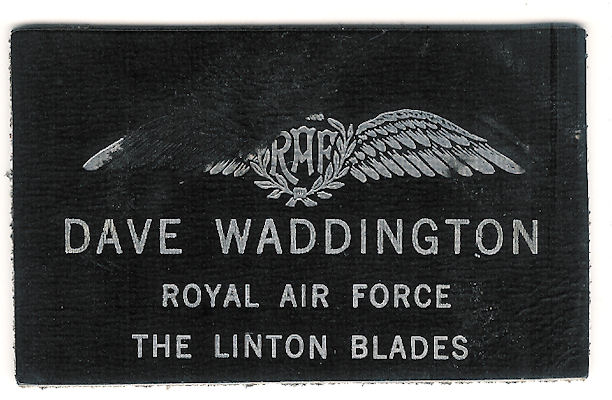
Mary Waddington ( wife of the '70 leader Dave Waddington ), also remembers the name change being very emotive. She says :- "Various suggestions were made for the new name. A couple of which Dave [Waddington] quite liked. The least favourite being "The Linton Blades". However the final choice was made by the AOC's wife, much to everyones dismay.
However, as I write this in 2010, "The Blades" has lost it's innuendo's from the 60's/70's and is the name of a current aerobatics team see => www.TheBlades.biz
The name stands the test of time quite well I feel.
In early 1970 the all new Jet Provost T5 had arrived at Linton. This was much more powerful that the T4 & had a pressurized cockpit. The team wasted no time in using it. The T4's were never used again by the team for shows or training flights
Some of the 1970 aircraft had a large "Blades Rose" symbol ( see next photo for an example ) on the air intakes & a smaller version on the tail fin. However looking through the various photos that I've seen, aircraft marked up in this way seem to be the exception rather than the rule
Along with new name & aircraft came new suits, helmets, team patches & name badges.
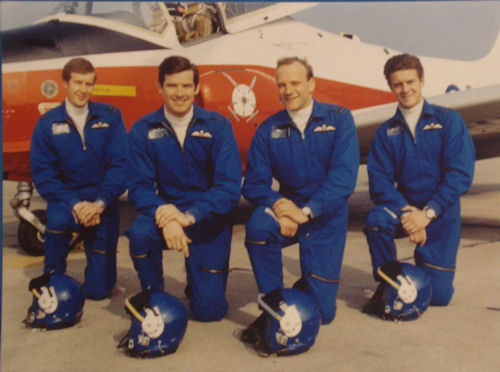
This picture was taken quite early in the 1970 season. Later the team had "Linton Blades" patches on the left , under their wings. Here's part of Dave Coldicutt's suit, photographed whilst on display at the Linton Memorial Room in August 2010.
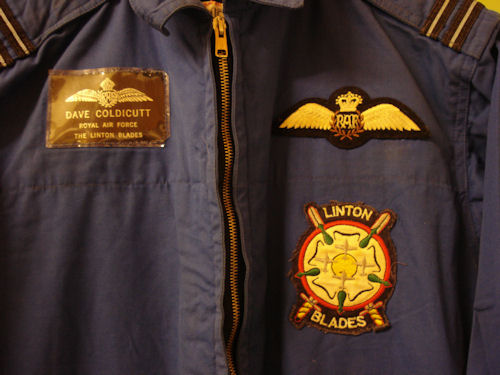
You may have also noticed the inclusion of the text "Royal Air Force" in the patches above., perhaps signifying that the team now had their sights set on a more international level.
For this season, 20 shows were flown on 18 different dates. 4 of these were flown in Germany.
Unfortunately the Navy left Linton-on-Ouse at the end of 1969, taking their Sea Prince with them. This was replaced by a van, to get spares to the UK shows. So you could argue not everything improved, but I could also argue it was more cost effective ;-)
The 1970 team was also featured on Television. A display was shown on Yorksports on YTV 31 October 1970. Does anyone have a copy of the pictures from this broadcast ? I have the soundtrack. Here it is. ( The Blades coverage starts 56 seconds into the file )
1970 Manager Sqn Ldr Bob Turner took command for the 1971 season. Flt Lt Dudley Carvell kept his seat, Flt Lt "Nobby" Grey & Flt Lt Alick Nicholson joined the team.
It looks like the season started with Owen Hammond as backup / adjutant / commentator, but towards the end of the season this was being done by Flt Lt Bob Joy. Bob went on to manage the Red Arrows in 73 & 74.
This team flew a massive 33 shows on 30 different dates ! including 2 in France, 2 in Germany & 1 in Italy ( & all their spare time ! ) The Blades were never to fly this many shows in a season again.
Paul Wrigglesworth was a Ground Crew member for the '70 & '71 seasons. He can't remember when he got it, but he has a "Blades" Plaque. No-one else seems to have one.
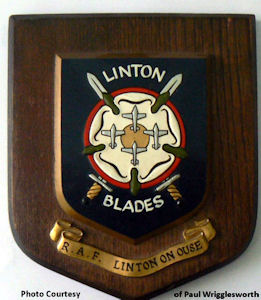
I can't find any evidence of the 1971 aircraft being marked any differently. Some of the '71 team aircraft still carried their '70 "Blades Rose"
1972 saw the return of the initial 1963 leader, Robbie Robinson. Now known as Sqn Ldr Duncan Robinson, he had a completely new team behind him. The rest of the team was Flt Lt Michael Hall, Flt Lt Peter Hood & Flt Lt Jon Buckler
Bob Joy was Adjutant / Commentator for all of this season.
According to a letter by Duncan, the initial plan was to increase the team to five aircraft, but this was reduced back to four in March 1972.
The aircraft were also repainted for the 1972 season. Whilst on the ground, the most obvious marking was the large yellow sword painted on the rudder but whilst in the air, the public could see there was also a large "Blades Rose" & Sword painted on the underside of the fueselage. See the "aircraft" link on the left for more details.
I believe the Blades was one of the first RAF Jet Provost teams to mark the underside of their aircraft.
Another first for the Blades was the appearance of special "collectors items" Post Office franked enevelopes. Here's one from the Woodford show in 1972, signed by the team.
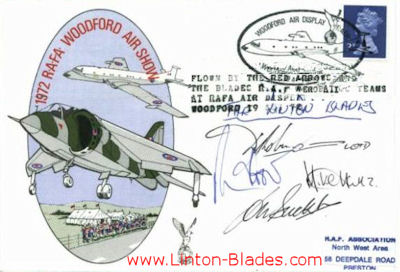
Sqn Ldr Robinson lead the team to 25 shows on 22 different dates, including 6 shows in Germany ( including one at the US airbase Ramstein ) & 1 in France ( Le Mans )
Also new for this season was an official brochure on the team. It was a glossy A4 paper printed on both sides.
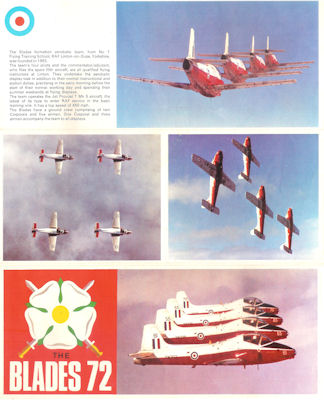
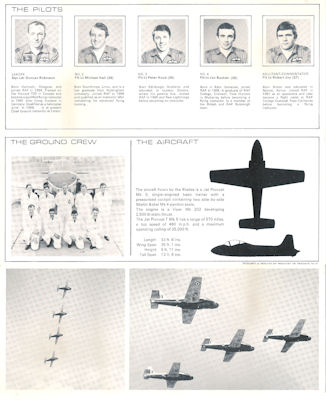
Many thanks to Willy Metze for sending me this brochure
Flt Lt Neil Carnegie was Adjutant / Commentator for 1973.
Argueably the most striking paint scheme for the team was to be the last. This year the aircraft were painted with standard training colours & a blue upper fueselage. The teams name was applied just below the cockpit.
This picture was taken from Mervin Fowlers log book.
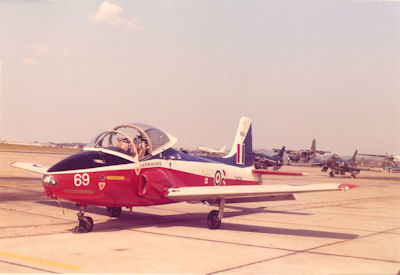
The team was due to have new blue flying suits for the 1973 season, these were ordered from a London based firm who made motor-racing suits. However when the suits arrived they were deemed to be unsuitable for the job, so the 1973 team borrowed the suits from the 1972 members. I understand these were returned to the 1972 members later.
Here's the 1973 official brochure for the team.
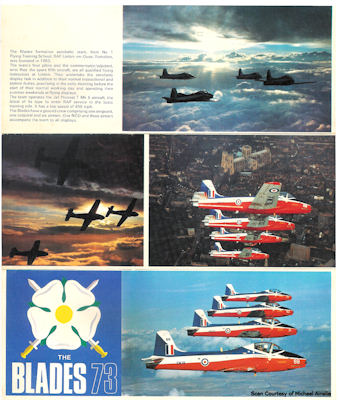
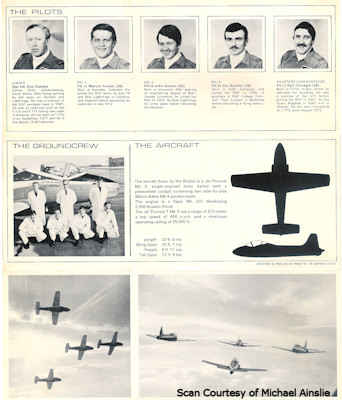
Many thanks to Michael Ainslie for sending me this brochure
Training & the initial shows for 1973 gave no indication as to what was coming. 8 shows were flown on 8 dates in 7 weeks. 2 shows in France & 1 in Germany.
A lot has been written about the demise of the team in 1973. Most of it blames the fuel crisis. However, the following article from an unknown newspaper describes what really happened.
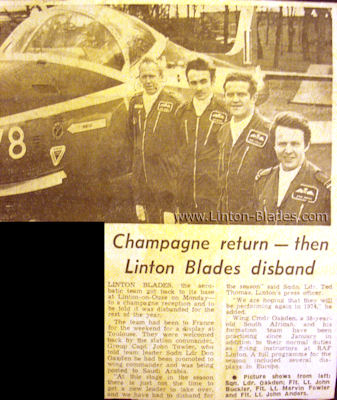
To give you an idea of how suddenly the team folded & how unexpected it was, the following advert appeared in Air Illustrated June 1973. The same month the team was disbanded.
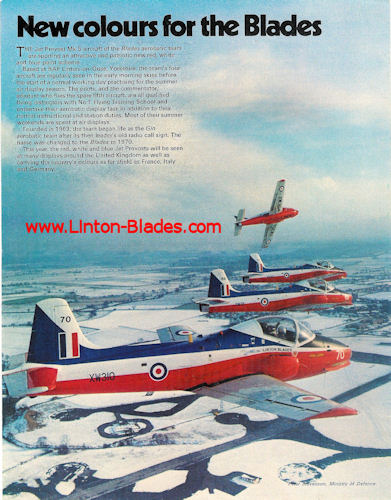
At least there was a team tie :-)
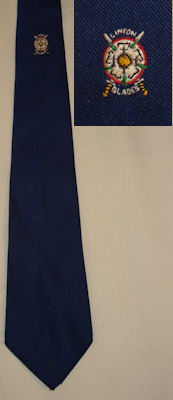
Neil Carnegie very kindly sent me his. - Thanks !
I don't think anyone would argue that the reason no 1974 team was formed WAS due to the fuel crisis.
Back